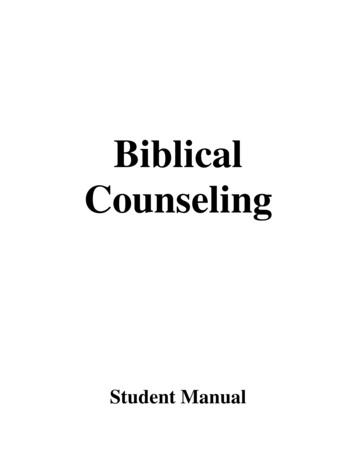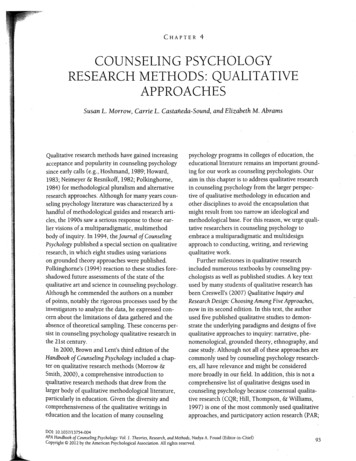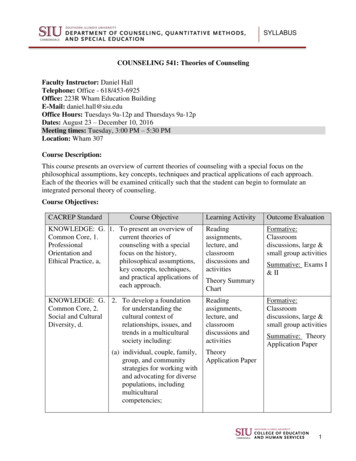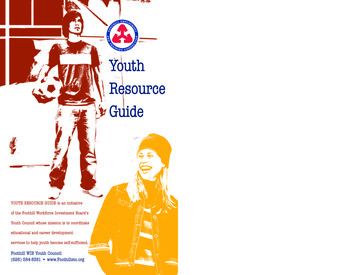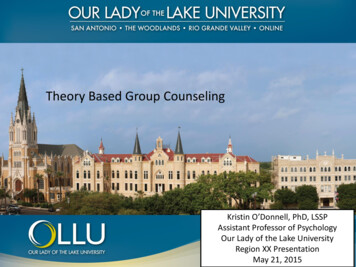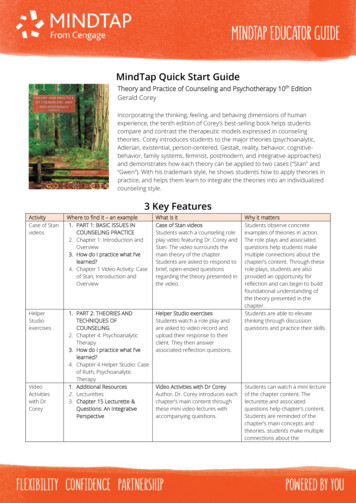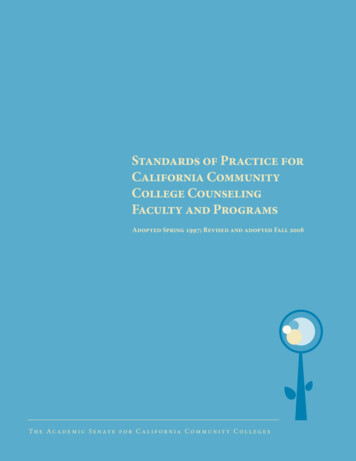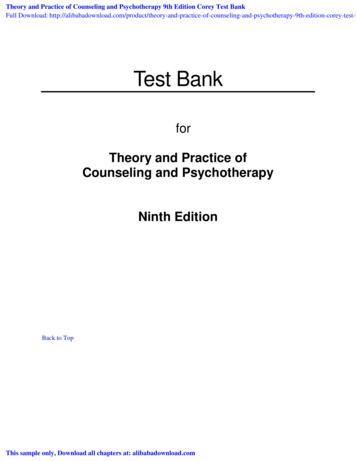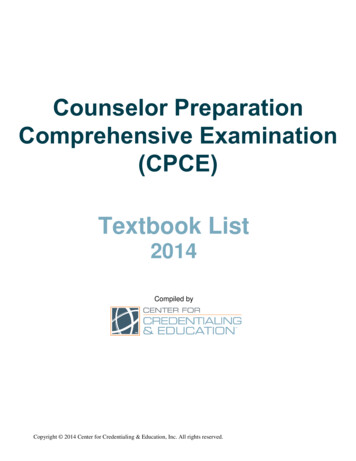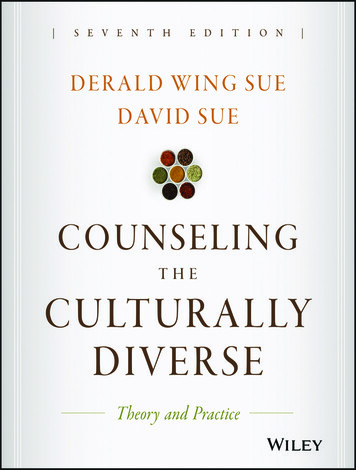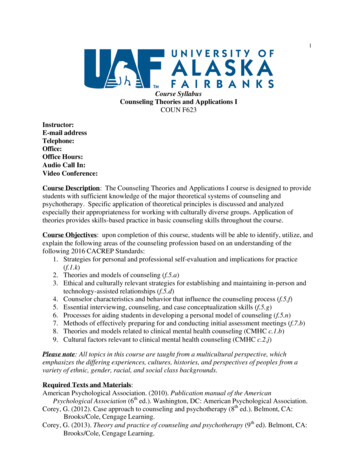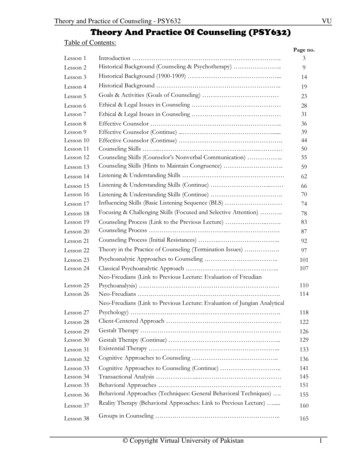
Transcription
Theory and Practice of Counseling - PSY632VUTheory And Practice Of Counseling (PSY632)Table of Contents:Page no.Lesson 1Lesson 2Lesson 3Lesson 4Lesson 5Lesson 6Lesson 7Lesson 8Lesson 9Lesson 10Lesson 11Lesson 12Lesson 13Lesson 14Lesson 15Lesson 16Lesson 17Lesson 18Lesson 19Lesson 20Lesson 21Lesson 22Lesson 23Lesson 24Lesson 25Lesson 26Lesson 27Lesson 28Lesson 29Lesson 30Lesson 31Lesson 32Lesson 33Lesson 34Lesson 35Lesson 36Introduction .Historical Background (Counseling & Psychotherapy) .Historical Background (1900-1909) .Historical Background .Goals & Activities (Goals of Counseling) Ethical & Legal Issues in Counseling Ethical & Legal Issues in Counseling Effective Counselor .Effective Counselor (Continue) . .Effective Counselor (Continue) .Counseling Skills . . Counseling Skills (Counselor’s Nonverbal Communication) .Counseling Skills (Hints to Maintain Congruence) .Listening & Understanding Skills Listening & Understanding Skills (Continue) . Listening & Understanding Skills (Continue) .Influencing Skills (Basic Listening Sequence (BLS) Focusing & Challenging Skills (Focused and Selective Attention) .Counseling Process (Link to the Previous Lecture) . .Counseling Process . .Counseling Process (Initial Resistances) . .Theory in the Practice of Counseling (Termination Issues) . .Psychoanalytic Approaches to Counseling .Classical Psychoanalytic Approach .Neo-Freudians (Link to Previous Lecture: Evaluation of FreudianPsychoanalysis) Neo-Freudians .Neo-Freudians (Link to Previous Lecture: Evaluation of Jungian AnalyticalPsychology) . .Client-Centered Approach Gestalt Therapy Gestalt Therapy (Continue) .Existential Therapy .Cognitive Approaches to Counseling .Lesson 37Cognitive Approaches to Counseling (Continue) .Transactional Analysis . Behavioral Approaches .Behavioral Approaches (Techniques: General Behavioral Techniques) .Reality Therapy (Behavioral Approaches: Link to Previous Lecture) .Lesson 38Groups in Counseling . Copyright Virtual University of 1011071101141181221261291331361411451511551601651
Theory and Practice of Counseling - PSY632VULesson 39Groups in Counseling (Continue) . .169Lesson 40Lesson 41Lesson 42Lesson 43Lesson 44Lesson 45Marriage & Family Counseling . 173178183187192199Marriage & Family Counseling (Continue) Career Counseling . .Community Counseling & Consulting . .Diagnosis & Assessment . .Final Overview . Copyright Virtual University of Pakistan2
Theory and Practice of Counseling - PSY632VULesson 01INTRODUCTIONCounseling is a distinct profession that has developed in a variety of ways in 20th century. It is avery useful area; on one end it will equip the students with basic theoretical and practical knowledge aboutthe subject, on the other end it will teach how to understand and improve oneself, and also how to maintaingood interpersonal relationships. Also it teaches how to develop good communication and relationshipskills.Course ContentThe main sections of the course are as under:Part I: Introduction to foundation and historical backgroundPart II: Counseling process and methodsPart III: Theories of counseling and interventionsPart IV: Assessment in counselingPart V: Counseling situationsCourse ObjectivesThe goal of this course is to present a comprehensive overview of counseling profession. This course hasbeen developed carefully to provide students with a thorough overview to the discipline of counseling. Afew objectives of this course are described below: To understand theoretical foundations of counseling psychology: Each theory is addressed from theperspective of background, human nature, major constructs, applications, the process of change, andintervention strategies, evaluation. To critically examine the major theories of therapy in the framework of one’s own background, valuesand professional goals. To indulge in self-assessment – one’s own needs and motivations, and personal characteristics that willeither help or hinder one in becoming a professional in human services. To understand basic counseling skills as practiced by an effective counselor. To discuss special settings and populations where counseling could be effectively used. To explore ethical and legal issues for the practice of counseling profession.Reference List Gladding, S.T. (2003). Counseling: A Comprehensive Profession (5th ed.). Prentice-Hall Career &Technology. Corey, G. (2004). Theory and Practice of Counseling and Psychotherapy (7th ed.). Wadsworth Publishing. George, R.L. (1986). Counseling Theory and Practice. New Jersey: Prentice-Hall.Counseling Journals Counseling (by British Association for Counseling) British Journal of Guidance & Counseling The Counseling Psychologist (by American Psychological Associaton) Psychodynamic Counseling International Journal of Psychotherapy European Journal of Psychotherapy, Counseling and Health Copyright Virtual University of Pakistan3
Theory and Practice of Counseling - PSY632VUMain Features of this Course Classroom Activities: The counseling will provide actual demonstrations of different counseling skillsand other practical aspects of the course will relate theory to practice of counseling. At the same time, itwill also clear up students’ misconceptions about how a therapy actually works. Case Approach: Case study consistent with the theoretical model under discussion will be presented tofurther clarify the theoretical concepts. The case approach to counseling emphasizes the use ofdemonstrations and attempts to bridge the gap between the theory and practice of counseling. Counseling Journal: Students will be expected to write their experiences regarding practice of differentcounseling skills.Students’ LearningAt the end of this course, the students shall be able to: Demonstrate foundational knowledge in counseling psychology (concepts, theories, ethical issues,basic skills, etc.). Apply this knowledge in improving one’s own life as well as to understand others in a better way. Use basic counseling skills (attending and listening skill) in improving their relationships.Definitions of CounselingAs a profession counseling is relatively new. It grew out of guidance movement, in opposition to traditionalpsychotherapy. A few definitions described below will illustrate the meaning and process of counselingprofession: “An effort to help the client engage in those types of behavior which will lead to a resolution ofthe client’s problems” (Krumboltz, 1965). “Counseling denotes a professional relationship between a trained counselor and a client.Relationship is usually person-to-person, and is designed to help clients to understand and clarifytheir views of their lifespace, and to learn to reach their self-determined goals through meaningful,well-informed choices and through resolution of problem” (Burks & Stefflre, 1979, p. 14) “An interaction in which the counselor offers another person the time, attention, and respectnecessary to explore, discover and clarify ways of living more resourcefully, and to his or hergreater well-being” (The BAC, 1999)These definitions indicate that counseling as defined by different people have few common components, asdescribed below: “Counseling is aimed at helping people make choices and act on them” Counselors are the people who listen to others and help resolve difficulties A relationship: Counselor develops a relationship which is based on unconditional positive regard andtrust. A process: Counseling is a process in which the counselor and the clients involve themselves in apsychological process to solve problems. The counseling is designed to help people make choices and solve problems. The counseling helps in recognizing one’s potential and to use this potential in an effective way.Counseling as a Helping RelationshipCounseling shares many characteristics of other helping professions. People working in these professionsare expected to help others, e.g., medical doctors, psychotherapists, nurses, paramedics, school counselors,etc. According to Rogers (1961, p. 40), helping relationship is defined as: Copyright Virtual University of Pakistan4
Theory and Practice of Counseling - PSY632 VU“Helping relationship is the one in which at least one of the parties has the intent of promoting thegrowth, development, maturity, improved functioning, improved coping with life of the other”.This definition describes various interpersonal relationships in social settings, e.g., mother-child, teacherstudent and many other relationships where people interact with each other and their interactions affectbehaviors and attitudes of others. However, counselor-client relationship affects in a unique way, differentfrom other interactions.In the following, certain characteristics of helping professions are described. All of these are also found inclient-counselor relationship.Characteristics:Affectiveness: Helping relationships is more affective (with feelings and emotions) than cognitive.Intensity: Counselor and client are expected to share openly their perceptions and reactions to each otherand to the process.Growth: The relationship is dynamic. As the client grows and changes, so does the relationship. Counselingis a unique and dynamic process in which, from counselor and client, one assists the other. The counselorhelps the client to grow in a positive direction and actualizing his own resources to grow.Privacy: During or after the counseling session all client disclosures are confidential.Support: Counselors, through counseling relationship, offer the client a system of support that oftenprovides the necessary stability for taking risks and changing behavior.Honesty: The helping relationships is based on honesty and open and direct communication between thecounselor and the client.The above characteristics indicate that the counselor will provide support to the client. However, counselingrelationship is not befriending, as in friendship both people share with each other but in counseling sharingis one-sided. However the supporting elements are strong in both friendship and counseling relationships.Is Counselor Simply a Helper?The helping relationship is the cornerstone on which counseling profession rests. This topic has beenstudied at length by various authors. The word helper is used as a short-hand term to describe both; bothcounselors and informal helpers use helping skills, e.g., plumber, electrician, guide, student counselors, etc.However, counseling is a help provided in a professional and ethical way. Egan (1994) mentions the termskilled helper to define a professional counselor.Nelson-Jones (1997) differentiates both in the following way: Anyone who provides a service could be regarded as a helper but not counselor.The word helper has connotations of placing recipients of help in dependent position and thehelper does things for the person rather than with him or her (which counselor is supposed to do.The word help obscures the idea of self-help. The purpose of counseling to help people is tobecome their own helpers, so both helpers and recipient of help ultimately become helpers. Thepoint is that when both are ultimately able to provide help, how the term of helper can beemployed for just one (counselor) of the two persons. Copyright Virtual University of Pakistan5
Theory and Practice of Counseling - PSY632VUCharacteristics of CounselingCounseling as a RelationshipCounseling is sufficient for constructive changes to occur in clients (Rogers, 1957). The counselingrelationship is characterized by core conditions namely empathy, unconditioned positive regard, andgenuineness.Counseling as a Repertoire of InterventionsIn counseling several questions (like which, when, and with what client) are answered and whileinterventions are decided an attempt is made to have a match between the client and the counselor.Counseling as a Psychological Process Goals of counseling have a mind component Process is psychological Underlying theories are psychological: Some psychologists like Rogers, Albert Ellis and psychiatristslike Berne and Beck have contributed enormously to counseling theories. For example,information about human nature has been derived from psychological theories. Some people arguethat counseling is not a profession as it is used in so many disciplines in so many sphere of life, e.g.,loan counselors, business counselor, etc., but the difference is that professional counselors workaccording to some theoretical model. Psychological research contributes both to creating counseling theories and to evaluate counselingprocess.Guidance & Counseling Guidance has been flip-flopped with counseling for over 50 years. The word guidance has historicalsignificance in the history of counseling, although not much in use now. Guidance is an umbrella term that includes such a constellation of services aimed at personal andcareer development and school adjustment. Guidance also describes the overall school/ collegeprogram and implies personal assistance to students, teachers, parents and administrators. Guidance is a relationship between the unequal. While counseling has been perceived as a processin which someone who has a problem receives personal assistance, usually through privatediscussion. Guidance focuses on helping individuals choose what they value most; counseling focuses onhelping them make changes. Counseling has been perceived as a process in which someone whohas a problem receives personal assistance, usually through private discussion. The term"counseling” not used exclusively by school counselors or other professional counselors, is used bypeople in the counseling profession to describe a special type of helping process.Distinctions between Counseling & PsychotherapyHahn (1953) writes, “I know few counselors or psychotherapists who are completely satisfied that cleardistinctions have been made”. Hahn goes on to point out that the most complete agreements are thatcounseling and psychotherapy cannot be clearly distinguished; counselors practice what psychotherapistsconsider psychotherapy, and psychotherapists practice what counselors consider to be counseling, anddespite the above they are different.Blocher (1966) distinguishes between counseling and psychotherapy by pointing out that the goals ofcounseling are ordinarily developmental-educative-preventive, and the goals of psychotherapy are generallyremediative-adjustive-therapeutic. He describes that five basic assumptions about client and counselordifferentiate both: Copyright Virtual University of Pakistan6
Theory and Practice of Counseling - PSY632 VUCounseling clients are not considered to be “mentally ill”, but they are viewed as being capable ofchoosing goals, making decisions, and generally assuming responsibility for their own behavior andfuture development.Counseling focuses on present and future.The client is a client, not a patient. The counselor is not an authority figure but is essentially ateacher and partner of the client as they move towards mutually defined goals.The counselor is not morally neutral or amoral but has values, feelings, and standards of his/herown. Although the counselor does not necessarily impose these on clients, he or she does notattempt to hide them.Counselor focuses on changing behavior, not just creating insight.Brammer & Shostrom (1982) indicate that while the two activities may overlap, counseling in general can becharacterized by such terms as “educational, vocational, supportive, situational, problem-solving, consciousawareness, normal, present time, and short-term”; psychotherapy can be characterized by such terms as“supportive (in a crisis setting), reconstructive, depth emphasis, analytical, focus on the past, emphasis on‘neurotic’ or other severe emotional, and long-term problems.Counseling & Psychotherapy: Differences Differences in origins Differences in goals Differences in process Differences in issues/ settings Differences in clients Differences in training & orientationDifferences in OriginsCounseling evolved from the human potential movements of late 1950s and 1960s; many of thepsychotherapies have their roots in psychoanalysis although many schools evolved and have broken away.The goals of psychotherapy are more likely to involve a quite complete change of basic character structure,and reconstructive. In contrast, counseling is directed toward aiding growth.Differences in GoalsIn psychotherapy the goal is to change the personality while counseling deals with the goal of helpingpeople to utilize existing resources for coping with life better.The goal of counseling is to help individuals deal with the developmental tasks appropriate to their age. Theadolescent who is being helped with problems of sexual definition, emotional independence from parents,career decision making and preparation , and the other tasks typical of that age in different cultures wouldbe receiving counseling. Similarly, a middle-aged person grappling with stresses of his age would seek thehelp of a counselor. However, more emotional and severe problems will be under the domain of apsychotherapist.The goals of psychotherapy are more likely to involve a quite complete change of basic character structure;the goal of counseling are apt to be more limited, more directed towards aiding growth, more concernedwith the immediate situations, and aimed at helping the individual function adequately in appropriate roles.Differences in ProcessIn the process of psychotherapy emphasis is on the past while the process of counseling emphasize on thepresent. Copyright Virtual University of Pakistan7
Theory and Practice of Counseling - PSY632VUThe purpose of the process of psychotherapy is treatment of the patient but counseling proceeds with thepurpose of the growth of the client.Psychotherapy and counseling also differ in frequency and depth of work. In psychotherapy usually therewill be 20-40 sessions over the period of 6 months to 2 years, while in counseling sessions will be limited,i.e., 6-12 sessions and the duration shall be usually less than 6 monthsDifferences in issues/ settingPsychotherapists are more apt to work in hospital settings or in private practice; counselors are more apt towork in educational settings. A wide range of settings/ issues for counselors are self awareness, relationshipdifficulties, abuse, anxiety, self-harming, vocational problems, lack of assertiveness, career transitions, etc.Suitable clients: Similarities & DifferencesThe counselor deals with normal persons and the psychotherapist deals with neurotic or psychotic persons.Such a distinction, of course, has many of the same built-in problems in the definition of “normal” as areinvolved in the distinction between counseling and psychotherapy.Both counseling and psychotherapy utilize a common base of knowledge and a common set of techniques.Both involve a psychotherapeutic process but they differ in terms of the severity of the client’s situation, interms of the client’s level of problem and/or functioning. Since the process does not change-only thesituation or the client’s concern may-we use the term interchangeably.There are also few similarities in clients and patients of counseling and psychotherapy, for example both are: Articulate Motivated CommittedApart from similarities, both disciplines share many differences as well, for example, psychotherapy patientscould have personality disorders, at risk of breakdown or mental illness, and thus might require an access toa consultant psychiatrist. As compared to that, counseling clients require more insight so that they could beable to take responsibility for their emotions and decisions.Differences in Training & OrientationSome practitioners of counseling may be trained at the doctoral level with a supervised internship, aspsychotherapists are. But many counselors have less training, with relatively little psychology and little or noformal supervised internship. More objective observers distinguish between counseling and psychotherapyon the basis of the extent of training in personality theory, research methods, and formal internship. Copyright Virtual University of Pakistan8
Theory and Practice of Counseling - PSY632VULesson 02HISTORICAL BACKGROUNDCOUNSELING & PSYCHOTHERAPYSimilarities between Counseling & PsychotherapyCounseling and psychotherapy are similar in many procedures and concepts. Some of them are given below: Both have the same seating arrangements and directions during the process of conducting sessions. In both psychotherapy and counseling special relationship is built and both value clients. Psychotherapists and counselors use the same theoretical models. Counseling skills are used by those practicing psychotherapy and counseling. Both psychotherapy and counseling have same ethical and professional boundaries like confidentiality,time limits, payments, ethical issues.Similarities in the process of both disciplines are shown in Figure 1.Figure 1: Process in Counseling & PsychotherapyInitial structure establishedDevelop rapportExploration of self, perceptualField, and behaviorsProblem identificationPossible assessment andAcquisition of environmentalInput, such as informationassimilationProblem solvingPlan of actionDecision makingFollow-up and possibleDevelopment of additionalstrategiesTerminationHistorical Development of the Counseling ProfessionCounseling as a distinct profession has developed in a variety of ways during the 20th century.Counseling has emerged and developed largely as an American product in the 20th century. Itsacceptance and widespread use in the USA far exceeds that of other countries. The development incounseling profession can be roughly divided into two broad categories:Our heritage from the past: Before 20th Century 20th century- To date:The development in 20th century and later years is largely attributed to following landmark events/factors: Copyright Virtual University of Pakistan9
Theory and Practice of Counseling - PSY632 VUVocational Guidance MovementMental Health MovementStandardized testingLicensure and legislationOur Heritage from the Past: Before 20th CenturyPrimitive Times Primitive societies shared fundamental economic enterprises, that is why no elaborates career guidancewas required at that time. Most of the career-related conflicts of present-day society were absent in earlyprimitive life. It is quite possible that the earliest (although unconfirmed) occasion in which humanssought a counselor was when Adam reaped the consequences of his eating the apple in the Garden ofEden. An abundance of evidence suggests that persons throughout the ages have sought the advice andcounsel of others believed to possess superior knowledge, insight, or experience. Perhaps the firstcounterparts of the present-day counselor were the chieftains and elders of the ancient tribal societies. Later, as skills became more recognizable and important to societies, occupational trades began to passeddown, mostly within families. However, no elaborates career guidance programs were developed orneeded because occupational limitations were usually determined by two criteria: age and sex. Thus,potters passed on the secrets and skills of their trade to their sons, as did the smiths and carpenters.Women passed on their skills to their daughters. Anyway, the occupational opportunities were limitedin those times. A study of early primitive life can lead one to conclude that most of the conflicts existing in present-daysociety regarding career decision making were absent.Early Greek CounselorsIn the early civilizations, the philosophers priests, or other representatives of the gods and religions assumedthe function of advising and offering counsel. The historic origins of the concept of developing one’spotential may be identified in the early Grecian societies.Plato:Plato is generally recognized as one of the first to organize psychological insight into a systematic theory.Belkin (1975) noted Plato’s varied interests: Education, persuasion, and most importantly a method to dealwith these questions (through real human interactions). Dramatic method: through the dynamics of realhuman interaction in which characters are as important as the things they say)Aristotle He studied how people interact with their environment and others.Hippocrates:He indicated that mental disorders were diseases due to natural causes. In 4th century BC, he suggested thatthe disturbance of four humours in body causes different behavioural problems. He in fact provided thefirst medical model of behaviour problems.Early Hebrew, Christian and Islamic Teachings emphasized the rights of individuals and humanistic ideals.Many contributions of that time can be similar to what was later to develop in the field of psychology. Theprimary concepts of all religions later in 20th century provided basics to democratic societies and counselingmovements. Copyright Virtual University of Pakistan10
Theory and Practice of Counseling - PSY632VUMiddle Ages (10th – 15th Century)During middle ages, attempts at counseling increasingly came under the control of church. At that time educationwas also largely under church jurisdiction. By the early middle ages, the duty of advising and directing youth hadbecome centered in the parish priest.A few important characteristics of middle ages are as under: Return to demonological explanations. Church became the primary social and legal institution in Europe. Physicians became the doctors to treatthe mentally ill. Exorcism again was practised. Priests diagnosed people by looking for signs of the devil, e.g., rashes and dead skin spots (by pricking)Muslim Traditions in Counseling & PsychotherapyDark ages were not dark for Muslims. While demonology persisted in the Western world, Muslimcivilization was at its peak. Al-Razi, Al-Ghazali, Ibn-e-Miskwayh, Ashraf Ali Thanvi laid greatemphasis on the development of the whole man; common therapeutic goals are changing man’srelationship to God as well as to society. They put forward a radical humanistic approach by givingrespect to individuals. They held that man has the potential to grow by using his inner resources. Theyalso believed that ignorance was disease and knowledge was cure.16th CenturyPhilosophers and educators, such as Luis Vives (1492-1540) recognized the need to guide persons according to theiraptitudes.17th CenturyBooks like “Tom of All Trades: Or the plain pathway to preferment” (Powell, 1631) aimed at helping youths choose anoccupation. Also during this time, Rene Descartes (1596-1650) and others began to study human bodyas an organism that reacted or behaved to various stimuli. These studies were to be forerunners for latermore accurate and scientific studies.18th Century:In the 18th century Jean-Jacques Rousseau (1712-1778) suggested that the growing individual can best learn whenfree to develop according to his or her natural impulses. He advocated permissiveness in learning and learningthrough doing.The famous Swiss educator Johann Pestalozzi (1746-1827) expressed the belief that society could be reformed onlyto the extent that the individual in that society was helped to develop.19th CenturyUS Educator Horace Mann in his 12th Annual Review stressed on main-stream schools and that the objective ofeducation should be to reform society. Mann reported that “in teaching the blind and the deaf and dumb, in kindlingthe latent spark of intelligence that lurks in an idiot’s mind and in the more holy work of reforming abandoned andoutcast children, education has proved what it can do by glorious experiments. Mann also believed that educationshould have as one of its objectives the reform of society.The biologist Herbert Spencer (1820-1903) set forth his concept of adjustment. This biological concept held thatforms of life that do not adapt their environment eventually become extinct. From this, Spencer concluded thatperfect life consisted of perfect adjustment. In other words, biological adjustment is criterion of life. Adaptivebehavior is that which maintains life. Copyright Virtual University of Pakistan11
Theory and Practice of Counseling - PSY632VUBy the end of 19th century, several influential figures contributed to the field of Psychology, e.g., William James,Wilhelm Wundt, Albert Ellis, Perls, etc. The work of some psychiatrists also influenced the field of counseling. Forexample, Sigmund Freud’s psychoanalysis influenced later prominent theorists of Perls, Ellis, and Adler. Similarly,Dorothy Dix advocated organic than moral treatment (prevalent at that time) at least for seriously mentally ill.20th Century – To date1900-1909: Vocational Guidance MovementIn 20th century, when society was growing more complex, and finding one’s appropriate place in society becameincreasingly complicated, it seemed a ripe time for a genuinely scientific approach to meeting many human needs.The time had come for the development of counseling to meet these needs. However, no single date can mark thebeginning of counseling.The counseling profession entered the schoolhouse in the early 20th century. Three persons emerged as leaders inthe development of counseling: Jesse B. Davis Frank Pars
Theory and Practice of Counseling and Psychotherapy (7th ed.). Wadsworth Publishing. George, R.L. (1986). Counseling Theory and Practice. New Jersey: Prentice-Hall. Counseling Journals Counseling (by British
